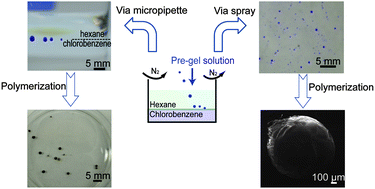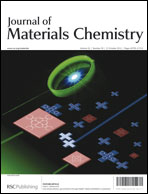Liquid–liquid interface assisted synthesis of multifunctional and multicomponent hydrogel particles
Abstract
We present a new method to synthesize hydrogel particles by exploiting the interface formed between two immiscible liquids. Spherical monomer droplets, of varying diameters, could be suspended at the planar interface formed between two immiscible liquids. While suspended, polymerization could proceed, after which the hydrogel particles that were formed could be collected. Using this approach, we were able to synthesize particles containing various monomers/co-monomers including: N-isopropylacrylamide, 2-hydroxyethyl methacrylate, and N-(3-aminopropyl)methacrylamide hydrochloride. The approach also allowed for the facile encapsulation of various inorganic nanoparticles and small molecules, including: Au nanoparticles, Ag nanoparticles, magnetic cobalt (Co) nanoparticles, tris(4-(dimethylamino)phenyl)methylium chloride (crystal violet) and fluorescein isothiocyanate isomer I (FITC). The benefit of this approach is the ability to load polymer particles with a wide variety of moieties without the need to optimize any reaction conditions. So long as the species to be encapsulated in the particle are soluble in water, and minimally soluble in the solvents used to form the interface, they will be incorporated in the polymerized particle.


 Please wait while we load your content...
Please wait while we load your content...